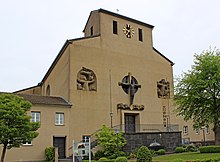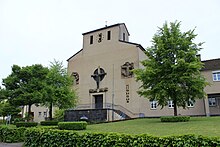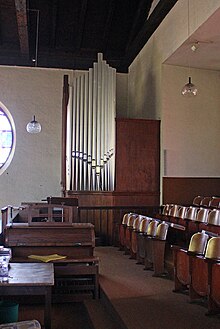St. Agatha (Merchingen (Merzig))
The Church of St. Agatha is a Roman Catholic parish church dedicated to the early Christian virgin and martyr Agatha of Catania in Merchingen , a district of Merzig , district of Merzig-Wadern , Saarland . The church building listed as an individual monument in the Saarland's list of monuments is considered to be trend-setting for the more modern history of church architecture in German-speaking countries.
history
The first documentary mention of a chapel dedicated to St. Agatha in Merchingen dates back to 1494. According to an episcopal visitation protocol from 1657, Merchingen was a branch of the parish of St. Peter in Merzig and was cared for by the Premonstratensians of the Wadgassen Abbey .
The chapel from the 15th century was replaced in 1793 by the construction of a new church in the same place. This church was finally elevated to a parish church after Merchingen, after decades of efforts, was spun off from the Merzig parish on June 5, 1821 and became an independent parish. In 1823 the church was expanded to include a choir , a sacristy and a tower . The installation of a gallery in 1869 gave the church additional seats, but as early as 1870 the church was considered too narrow and was also in poor structural condition.
In 1907, the parish founded a church building association , and plans for a new church began, but this was thwarted by the outbreak of the First World War . A good ten years after the end of the war, Pastor Johann Speicher, who took office in April 1928, revived the church building association so that the planning and the procurement of the necessary financial resources for the construction of a new church in Merchingen could be tackled again. In 1929 the last Eucharistic celebration took place in the old church .
In June 1928, Pastor Speicher wrote a letter to the architect Clemens Holzmeister ( Vienna ), in which he asked Holzmeister to draw up the plans for the new church. He showed interest, and after a visit to Merchingen, Holzmeister presented the first drafts in October 1928.
On May 10, 1929, work began on the construction site and the excavation of the foundations . The actual construction work began on June 7, 1929, and the foundation stone was laid on July 14, 1929 . The topping-out ceremony for the builders took place on October 12, 1929. It was followed by the building safety approval on 14 November 1929, the carcass work acceptance on 15 November 1929 and on 22 December 1929, the benediction with the transfer of the Blessed Sacrament and the first Holy Mass is celebrated . The consecration was carried out on June 1, 1930 by Trier Auxiliary Bishop Antonius Mönch . The rectory and parish hall, which form an architectural unit with the church, were ready for occupancy in November 1930. The final artistic design of the church dragged on until 1935.
Due to concrete damage , the first restoration of the church was necessary in 1934 . The old church from the 18th century was demolished in 1937.
During the Second World War , the church building was hit by nine artillery shells in the winter of 1944/45 and badly damaged. The interior was also badly damaged. Due to a shortage of materials and money, the damage could only be repaired in the first years after the war.
From 1979 to 1985 the church underwent extensive renovation and restoration, the cost of which amounted to around one million DM .
In 2000 Merchingen became part of the newly formed pastoral care district Merzig, which also includes the parishes, Bietzen , Brotdorf , Merzig-St. Josef and Merzig-St. Peter belong. Later still came Besseringen added.
In 2002, as part of the “KinOrgel” project, the church was used for a secular secondary use for experimental cinema.
In 2009 the bells were restored, and in 2010 the church building inside and outside.
architecture
The exterior of the warm concrete church is plain and simple. The rectory and the parish hall are attached to the church, which together form a unit with a continuous street front. The floor plan of the actual church building is a cross with a wide crossbar.
A wide, double-flighted staircase leads to the entrance portal , above which there is an ornamented round window. The round window above the portal, overlaid by a large concrete cross with a figure of Christ carved from sheet copper , is flanked on the left and right by cast reliefs . The reliefs show the scene of the Mount of Olives on the left and the resurrection on the right.
The church has two towers. On the one hand the bell tower , which is part of the front facade, and a tower, which is located at the opposite end of the church building. The bell tower has three sound holes on its front, with the gold-plated dial of the tower clock above the middle sound hole . Another sound hole is in the gable ends. The bell tower is crowned by a ball with a cross. The second tower, which towers over the main nave by four meters, is broken through by five round windows. There is a simple, narrow concrete cross on its back. The second tower, which Holzmeister called the Sacrament Tower, has the function of supplying the chancel with indirect daylight that falls through the five high round windows.
In order to gather the community as close as possible around the altar, the architect Holzmeister dispensed with the traditional opposite of the altar and the believers in the interior. The broad main nave, extended by two transverse arms, enables the faithful to see the altar.
The simple objectivity of the church did not initially meet with approval everywhere at the time of its creation and sparked a lively discussion in the Roman Catholic world. Holzmeister's sacred building was referred to as a “large farmhouse with a barn”, “blasphemy in the picture” or, more commonly, as a “farmer's church”. Today, however, the church is considered a prototype of modern church construction.
Furnishing
Holzmeister designed the interior design between 1929 and 1930. The majority of the furnishings, from the church stalls to the communion bench , to the candle holders and lighting fixtures, are based on Holzmeister's sketches.
In cooperation with Holzmeister, glass painter Anton Wendling ( Aachen ) designed the windows of the church from 1929 to 1930, in which blue and red tones predominate. Also vestments , carpet and Hungertuch were designed at the same time together by Holzmeister and Wendling.
The painter Peter Hecker created the painting in the chancel between 1933 and 1934, which was restored in 2010. The painting in the baptistery , which was created at the same time, was also by Hecker.
The wooden figures inside and the sculptures on the outer front were created between 1929 and 1930 by the sculptors Jakob Adlhart and Karl Bodingbauer ( Tyrol ).
The ensemble of carpet runners created in 1999 was knotted in Nepal and dyed in Switzerland .
Originally made for the church in 1929, the woodcut of the Way of the Cross by the poet, sculptor and draftsman Ruth Schaumann (Munich) has been in the St. Josef Church in Lebach - Falscheid since 1960 .
organ
In 1951 the church received its first organ , built by the company Späth ( Mengen ), which was put into service on Christmas of the same year. In the year 2000 Hubert Fasen installed two setting combinations.
The Kegelladen instrument has 7 (8) registers distributed over a manual and pedal . The original planning provided for a second manual, which was not built for cost reasons, whose work on the gallery would have stood opposite the existing one with the same appearance. The game and stop action is electro-pneumatic.
The disposition is as follows:
|
|
||||||||||||||||||||||||||||||
- Pairing : I / P
- Playing aids : 2 typesetting combinations
Bells
The oldest bell in Merchingen came from the 15th century and was cast in 1412, and probably recast in 1872. A second bell was added to this bell in 1621. For war purposes, one bell each had to be handed in during the First and Second World Wars, and these were replaced by new ones after the wars. In 1949 the church received a new bell, replacing the one previously confiscated during World War II. Four more bells were added to this in 1962. Since then there has been a five- bell ring in Merchingen .
| No. | Surname | volume | Weight (kg) | Foundry, casting location | Casting year |
| 1 | Christ the King | cis' | 2000 | J. Mark , Brockscheid / Eifel | 1962 |
| 2 | Agatha | e ' | 1200 | J. Mark, Brockscheid / Eifel | 1962 |
| 3 | Michael | fis' | 850 | J. Mark, Brockscheid / Eifel | 1962 |
| 4th | Joseph | g sharp ' | 650 | J. Mark, Brockscheid / Eifel | 1962 |
| 5 | Maria | H' | 340 | F. Causard, Colmar / Alsace (France) | 1949 |
Priest in Merchingen
- 1822–1823 Theodor Herzig
- 1824–1857 Johann Matthias Deutsch
- 1857–1863 Johann Paulin Hirschfeld
- 1863–1865 Friedrich Merziger
- 1865–1869 Johann Anton Grünewald
- 1869–1879 Wilhelm Peiffer
- 1885-1893 Johann Weyrauch
- 1894–1927 Peter Pies
- 1928–1939 Johann Speicher
- 1940–1950 Eugen Helms
- 1950–1961 Josef Kraus
- 1961–1976 Friedrich Hilgert
- 1976–1977 Winfried Schnur
- 1977–1994 Fritz Schmitt
- 1995-2007 Jürgen Waldorf
- since 2007 Bernhard Schneider
literature
- Seiwert, Theo: Parish Church of St. Agatha Merchingen - Diocese Trier, Dean's Office Merzig, patronage festival February 5, 2005 . Ed .: Parish Merchingen. 2005, ISBN 3-938415-04-5 .
- Old churches in new splendor [27]: Parish Church of St. Agatha in Merzig-Merchingen . 1986
- Parish Sankt Agatha <Merchingen, Merzig> (Ed.): 50 years Parish Church S [ank] t Agatha Merchingen: from June 21 to 24, 1980 . Merzig, 1980
- Literature on St. Agatha (Merchingen (Merzig)) in the Saarland Bibliography
Web links
- Web presence of the parish of St. Agatha, Merchingen
- The Merchinger Church
- Parish community Merzig St. Peter
Individual evidence
- ↑ List of monuments of the Saarland, partial list of monuments in the district of Merzig-Wadern ( Memento of the original dated May 2, 2014 in the Internet Archive ) Info: The archive link was automatically inserted and not yet checked. Please check the original and archive link according to the instructions and then remove this notice. (PDF) Retrieved March 15, 2015
- ↑ a b c d e Clemens-Holzmeisterkirchen in Merzig On: www.merzig.de. Retrieved March 15, 2015
- ↑ a b c d e f g Church history on: www.sankt-agatha-merchingen.de. Retrieved March 15, 2015
- ↑ a b c d e f g h i j k l m n Information on the parish church of St. Maria Magdalena Brotdorf on: www.kunstlexikonsaar.de. Retrieved March 15, 2015
- ↑ a b c Construction process at: www.sankt-agatha-merchingen.de. Retrieved March 15, 2015.
- ↑ Establishment of the Merzig St. Peter parish community in the Merzig deanery at: www.bistum-trier.de. Retrieved March 15, 2015.
- ↑ a b c The church from the outside On: www.sankt-agatha-merchingen.de. Retrieved March 15, 2015.
- ↑ The church inside : www.sankt-agatha-merchingen.de. Retrieved March 15, 2015.
- ↑ http://www.biographien.ac.at/oebl/oebl_B/Bodingbauer_Karl_1903_1946.xml , accessed on January 12, 2019.
- ↑ a b c d e organ of the cath. Parish Church of St. Agatha Merchingen On: www.organindex.de, accessed on March 15, 2014.
- ↑ Seiwert, Theo, Pfarrgemeinde Merchingen (ed.): Parish Church St. Agatha Merchingen - Diocese Trier, Dean's Office Merzig, Patronatsfest February 5, 2005.
- ↑ Information about the bells of the parish of St. Agatha according to the information board in front of the church
- ↑ The priests of the parish on: www.sankt-agatha-merchingen.de. Retrieved March 15, 2015
Coordinates: 49 ° 26 ′ 28 " N , 6 ° 40 ′ 46.4" E




